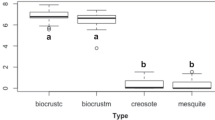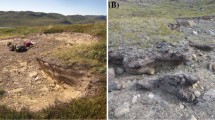Abstract
We examined the content and isotopic composition of nitrogen within soils of a juniper woodland and found that a cryptobiotic crust composed of cyanobacteria, lichens, and mosses was the predominant source of nitrogen for this ecosystem. Disturbance of the crust has resulted in considerable spatial variability in soil nitrogen content and isotopic composition; intercanopy soils were significantly depleted in nitrogen and had greater abundance of 15N compared to intra-canopy soils. Variations in the 15N/14N ratio for inter- and intra-canopy locations followed similar Rayleigh distillation curves, indicating that the greater 15N/14N ratios for inter-canopy soils were due to relatively greater net nitrogen loss. Coverage of cryptobiotic crusts has been reduced by anthropogenic activities during the past century, and our results suggest that destruction of the cryptobiotic crust may ultimately result in ecosystem degradation through elimination of the predominant source of nitrogen input.
Similar content being viewed by others
References
Belnap J (1993) Recovery rates of cryptobiotic crusts: inoculant use and assessment methods. Great Basin Nat 53:89–95
Belnap J, Gardner JS (1993) Soil microstructure in soils of the Colorado Plateau: the role of the cyanobacterium Microcoleus vaginatus. Great Basin Nat 53:40–47
Beymer RJ, Klopatek JM (1992) Effects of grazing on cryptogamic crusts in pinyon-juniper woodlands in Grand Canyon National Park. Am Midl Nat 127:139–148
Boring LR, Swank WT, Waide JB, Henderson GS (1988) Sources, fates, and impacts of nitrogen inputs to terrestrial ecosystems: review and synthesis. Biogeochemistry 6:119–159
Bowden WB (1986) Gaseous nitrogen emissions from undisturbed terrestrial ecosystems: an assessment of their impacts on local and global nitrogen budgets. Biogeochemistry 2:249–279
Campbell SE, Seeler JS, Glolubic S (1989) Desert crust formation and soil stabilization. Arid Soil Res Reh 3:217–228
Fiedler R, Proksch G (1975) The determination of nitrogen-15 by emission and mass spectrometry in biochemical analysis: a review. Anal Chim Acta 78:1–62
Fustec E, Mariotti A, Grillo X, Sajus J (1991) Nitrate removal by denitrification in alluvial ground water: role of a former channel. J Hydrol 123:337–354
Harper KT, Marble JR (1988) A role for nonvascular plants in management of arid and semiarid regions. In: Tueller PT (ed) Vegetation science applications for rangeland analysis and management. Kluwer Academic, Boston, pp 135–169
Heaton THE (1986) Isotopic studies of nitrogen pollution in the hydrosphere and atmosphere: a review. Chem Geol 59:87–102
Junge CE (1958) The distribution of ammonia and nitrate in rain water over the United States. Trans Am Geophys Union 39:241–248
Kleiner EF, Harper KT (1972) Environment and community organization in grasslands of Canyonlands National Park. Ecology 53:299–309
Mariotti A (1984) Atmospheric nitrogen is a reliable standard for natural 15N abundance measurements. Nature 311:251–252
Mariotti A, Germon JC, Hubert P, Kaiser P, Letolle R, Tardieux A, Tardieus P (1981) Experimental determination of nitrogen kinetic isotope fractionation: some principles; illustration for the denitrification and nitrification processes. Plant Soil 62:413–430
Minagawa M, Winter DA, Kaplan IR (1984) Comparison of Kjeldahl and combustion methods for measurement of nitrogen isotope ratios in organic matter. Anal Chem 56:1859–1861
Nadelhoffer KJ, Fry B (1988) Controls on natural nitrogen-15 and carbon-13 abundances in forest soil organic matter. Soil Sci Soc Am J 52:1633–1640
Peterjohn WT, Schlesinger WH (1990) Nitrogen loss from deserts in the southwestern United States. Biogeochemistry 10:67–79
Schlesinger WH, Reynolds JF, Cunningham GL, Huenneke LF, Jarrell WM, Virginia RA, Whitford WG (1990) Biological feedbacks in global desertification. Science 247:1043–1048
Shearer G, Kohl DH (1986) N2-fixation in field settings: estimation based on natural 15N abundance. Aust J Plant Physiol 13:699–756
Virginia RA, Jarrell WM (1985) Soil properties in a mesquite-dominated Sonoran Desert ecosystem. Soil Sci Soc Am J 47:138–144
West NE (1990) Structure and function of microphytic soil crusts in wildland ecosystems of arid to semi-arid regions. Adv Ecol Res 20:179–223
West NE, Skujins J (1977) The nitrogen cycle in North American cold-winter semi-desert ecosystems. Oecol Plant 12:45–53
Young JR, Ellis EC, Hidy GM (1988) Deposition of air-borne acidifiers in the western environment. J Environ Qual 17:1–26
Author information
Authors and Affiliations
Rights and permissions
About this article
Cite this article
Evans, R.D., Ehleringer, J.R. A break in the nitrogen cycle in aridlands? Evidence from δp15N of soils. Oecologia 94, 314–317 (1993). https://doi.org/10.1007/BF00317104
Received:
Accepted:
Issue Date:
DOI: https://doi.org/10.1007/BF00317104




